Griffy and Zippy
Forty and Counting
Zippy, the character, not the comic strip, passed the forty-year milestone late last year, and on May 26, the comic strip celebrated its 25th anniversary, just the day before its creator, Bill Griffith, made a presentation at the annual convention of the National Cartoonists Society, a happy coincidence that escaped our attention altogether here at Rancid Raves Intergalactic Wurlitzer. But to make up for our dereliction, we’re reprinting (and updating slightly) an interview we enjoyed with Griffith and published in Cartoonist PROfiles, No. 101 (March 1994).
AN ELOPEMENT
FROM UNDERGROUND COMIX, Bill Griffith's Zippy is easily the most
unconventional comic strip in the King Features stable. And the circumstances
surrounding its syndication by King are equally unusual. So eerie, in fact,
that the entire episode could have been lifted intact from the strip itself. 
In 1986, Griffith was doing a daily Zippy strip exclusively for Hearst's San Francisco Examiner and self-syndicating a weekly version to a small selection of newspapers. He had no ambitions for national daily syndication. Out of the blue, he got a phone call from Alan Priaulx, then Vice President of King Features, who wanted to meet him in San Francisco and talk to him. Griffith recounted the story when we talked in late September 1992:
"After a year of appearing daily in a large American newspaper," Griffith said, "I thought that was as weird as things were going to get for me. Little did I know they were going to get even stranger. Priaulx came out. I remember going to the meeting with a little list of things that I would require in order to work for them. And I had thought of the list as a way of not working for them: I was certain that they would never agree to these things. I said I have to keep my copyright. And I have to keep the larger format. I draw the strip out of proportion: it's taller than any other strip. It's not just that I want it to appear bigger proportionally: it's drawn so that it has more headroom [for dialogue]. And I said, I can't change that.
"You can't censor it," Griffith continued, recalling his list of requirements. "You can't edit it. You have to guarantee me a certain amount of money weekly because I'd be giving up my exclusive deal with the Examiner. I gave them a long list. I felt like I was taking hostages. And this guy sat across from me and said Yes instantly to everything."
Six months later, Griffith found out why Priaulx had been so accommodating: "I got a letter from him at his new job, somewhere in some completely different business; he just wanted to tell me what had happened, how Zippy had come to King Features. He said he wanted to leave King. He wasn't happy; it wasn't the right job for him. But he wanted to leave with a bang. And he said he felt that by hiring me and by adding Zippy to the King Features roster he was leaving a ticking time bomb on their doorstep as he left. He just wanted to shake up King Features. He just wanted to give them the weirdest strip in America."
I asked the obvious question: "So—did the time bomb go off? Have you run into trouble?"
"No," Griffith said. "None whatsoever. And I'm very grateful for that fact. I've had nothing but support from them. At the very beginning—the first year or two when Bill Yates was the comics editor—I would get a call once a month or so, and he would say, Do you have to use the word Jesus in your strip; it might offend the Bible Belt people. The very first time he said something like that, I said, Bill—that's an essential part of the point I was trying to make in that strip, and I can't change it. And he instantly said, Fine—no problem. So, no trouble. It's been a completely happy relationship. I think what Alan Priaulx did they actually liked. They liked the shake-up that I represented."
These days—that is, 2011—according to zippythepinhead.com, Zippy appears in about 200 newspapers worldwide.
ZIPPY HAS A LONG HISTORY that begins several years before Griffith's association with King Features. The character—indeed, Griffith's career as a cartoonist—can be seen as the triumph of the Milton Berle over the Jackson Pollock within Griffith. The struggle began at an early age.
Griffith grew up in Levittown, New York, the post World War II housing development that gave housing developments a bad name. All the houses looked exactly alike--a monotonous, sterile environment. But next door to the Griffiths lived "the only beatnik in town," the well-known science fiction illustrator Ed Emshwiller.
"Emsh" (as he signed his work) was an example to young Bill: he worked at home and made more money that Griffith's father. Although Griffith was fascinated by comics, he watched as Emshwiller began to experiment with abstract painting, and Griffith soon abandoned comics for painting. Except for Harvey Kurtzman's Mad. He appreciated its "subversive humor."
"Mad was a life raft in a place like Levittown, where all around you were the things that Mad was skewering and making fun of," he said. "Mad wasn't just a magazine to me. It was more like a way to escape. Like a sign, This Way Out. That had a tremendous effect on me."
But he still pursued the artist's muse, not the cartoonist's. After graduating high school in 1962, he went to Pratt Institute in Brooklyn and studied painting and graphic arts, leaving between his sophomore and junior years to spend a year in Paris, where he lived in a garret ("the top floor of a cheap hotel—I even had a skylight"). When he returned to Brooklyn in 1965, he freelanced at whatever art jobs he could find.
He moved to the Lower East Side of Manhattan in about 1967. There he saw his first underground comics, strips by Robert Crumb and Kim Deitch in the East Village Other. "I had repressed the comedian and the cartoonist in me for too long," Griffith recalled. "Seeing those Crumb things burst the bubble. I just did a comic strip one day [in late 1968] and took it down to Screw.
"The times being what they were, completely free-wheeling, it was relatively easy to get published. My message seemed to be sufficiently anti-establishment, anarchic— and, most important, I did the strip to the right proportions. I took it in to Steve Heller, who is now the art director at the New York Times, and he pulled out a ruler, and he said, Hey— it's the right proportions; we'll use it! I was one of the few contributing cartoonists who had bothered to measure what a half-page tabloid size was. And I'd drawn it the right size. I don't think they even read my first five or ten strips. They were just so thrilled that they were drawn to the correct proportions."
I said: "So now all aspiring cartoonists reading this will seize upon the right proportions as the direct route to— "
" —to fame and fortune," Griffith finished with a laugh. "Just measure correctly. The ruler is the pathway to stardom."
Griffith completed his education as a cartoonist by seeing his drawings in print. "I remember seeing my first strip in print and having the elation fade in about two minutes--just staring at this thing and being embarrassed by how it looked. Thinking, My gawd—I gotta go back and improve that foot; this lettering is not readable. And I started asking people what pens they used. I had to learn all the basics because I'd come to comics right out of painting. And doing art for black-and-white reproduction is a different game. I felt like I was drawing with a rock on concrete. Whatever grace I had develop with my art materials just evaporated when I was faced with a dip pen and a sheet of bristol, and knowing that the pencil wasn't going to help. It all had to be in ink; the pencil was just going to get erased. Everything was very tentative at first, but I am grateful that I had the opportunity to learn—in print—because that's the best place to learn. Seeing your work in print is almost like seeing it through someone else's eyes. You get this objectivity that you can never get from your original art."
Throughout 1969, Griffith's strips appeared in Screw and the East Village Other. Among his characters was an anthropomorphic amphibian, Mr. Toad. Mr. Toad was anger incarnate, primal anger; and he acted out his anger. Through Mr. Toad, Griffith assaulted the shams of the society around him. "He was cathartic," Griffith said.
IN EARLY 1970, SOME of Griffith's cartoons were published in Yellow Dog Comics in San Francisco, by then a Mecca for underground cartoonists. Griffith made a visit to San Francisco in April 1970, when his first underground comic book, Tales of Toad No. 1, appeared; then he moved there in July.
"It was a magnet," Griffith said. "There was no resisting the pull of San Francisco." For an underground cartoonist, it was, by then, about the only place to be. The underground newspaper comic strip in New York had expired by the end of 1970; comic books were the only outlet, and they were published most regularly in San Francisco. "Within a very short time, almost all the cartoonists had either come out here [to San Francisco] or had stopped doing comics. Everybody came out. I was just part of a wave of people coming out here."
For most cartoonists, cartooning is essentially a solitary occupation, but the ambiance of San Francisco at that time was more like the fabled Mermaid Tavern of Elizabethan times where people got together and chewed the fat and talked about what they were doing.
"It was like an art movement," Griffith said. "You joined an art movement; that was the feeling. It was a lot of things. First of all, it was a definite part of the hippie movement, the counter culture. We were part of the whole Haight Ashbury scene. By 1970, it had started to fade—or change, at least, the tail end of the counter culture—but it was still very much alive in the social sense of everybody feeling connected. There was a kind of party atmosphere to some degree; and then there was the sort of salon atmosphere. We hung around a comic book store called San Francisco Comic Book Company on 23rd Street in the Mission District here—which still exists and is run by the same owner, Gary Arlington, who eventually became a publisher and then that faded, and he's still at the stand selling comic books [or was in 1992, the vintage of this interview]. If we were a salon, he was Gertrude Stein. In fact, he kind of looked like Gertrude; he looks more like Gertrude Stein every year. We would hang out at the comic book store, and we would have regular parties at the publishers' offices, Rip Off Press and Last Gasp."
[For more about the Haight in those years, visit Harv’s Hindsight for July 2007, “The Lonely Hearts Club Band,” wherein is retailed a short history of underground comix and Robert Crumb’s career.]
The comix salon atmosphere often crackled with the causes of the counter culture's crusading spirit. Griffith explained:
"There were plenty of factions within underground comics just as there were within the prevailing counter culture so that some cartoonists felt a responsibility to promote certain ideas. And that's how Last Gasp was formed. Last Gasp was—and still is—officially called Last Gasp Eco Funnies, meaning ecology. [So] Last Gasp was not interested in printing Young Lust No.1, which was my first big hit, because they had a fairly strict, politically correct attitude, and Young Lust didn't fit into it. They thought it didn't have any socially redeeming qualities; and they were into printing things that were politically correct in terms of late-sixties early-seventies politics of the counter culture. I was always a little bit on the outside of that."
Griffith's Young Lust No. 1, a satirical parody of "young romance" comic books, appeared in October 1970 and was successful enough that from then on, Griffith was able to earn his living solely as a cartoonist. By working for every underground comic that would take him, he managed to support himself. "At the ridiculous page rate of $25 a page," he said, "if you worked really, really hard, you could make $100 a week."
He had one "bad year"—1973-74, the year the Supreme Court ruling on pornography virtually shut down production of underground comix. During that time, he worked with Art Spiegelman doing Wacky Packages (which Spiegelman invented) for Topps Bubblegum. In 1975, he joined Spiegelman in founding Arcade Comics, which the two edited (with the help of Willie Murphy, Griffith's roommate at the time) for seven issues. When it folded in 1976, Griffith started doing a weekly half-page comic strip for the Berkeley Barb. The strip was soon being distributed nationally to the underground press by a syndicate that Rip Off Press started. The strip was Zippy.
ZIPPY THE PINHEAD FIRST APPEARED as a comic character in a "true romance" satire that Griffith did in Real Pulp Comics No. 1 in late 1970. "Roger Brand—a cartoonist now deceased—was editor, and he urged me to do a really odd-ball romance story that took some unexpected turns and used characters that normally don't appear in romance comics—not Mr. Toad but something equally odd. I had recently seen the movie ‘Freaks,’ and I thought, Hey, why don't I use one of those pinheads from ‘Freaks’; that would be a pretty interesting character. Just for a one-shot story. And I went to visit a friend who had freak photographs, collected photographs of circus sideshow freaks.
"So I had all these pictures," Griffith continued, "and I did a story, a sort of ‘true confessions,' called ‘I Feel for a Pinhead but He Made a Fool Out of Me.' And Zippy didn't even have a name at the beginning. In fact, he got his name during the strip. And it was a very baroque love triangle involving two pinheads and a so-called normal female. So Zippy was born in that story without ever—on my conscious part anyway—having any intention to draw him again."
Zippy's name, Griffith once revealed, was derived from "Zip the What-Is-It," a pinhead exhibited for years with the Barnum and Bailey Circus. "His real name, by the way," Griffith added, "was William H. Jackson, the same as my great grandfather. And, since my full name is William H. Jackson Griffith, it's all the more unnerving."
Later, when Griffith needed a sidekick for Mr. Toad, he brought Zippy back into the picture, and within a year or so, the roles were reversed, and Mr. Toad became Zippy's sidekick.
I speculated: "So what you were looking for was a character with a personality the opposite of Mr. Toad?"
"Yes," he said, "Toad was an overbearing, hostile, egomaniacal self-destructive character who lived in the bubble of his ego. He couldn't really understand anybody else's existence much less their problems. Zippy was the character who didn't even recognize the border between himself and the world. It was one seamless reality to Zippy. Zippy also embodied some Zen qualities that I can relate to."
Rip Off's syndicate operation ceased in 1980, and Griffith started self-syndicating the feature through his own Zipsynd (later Pinhead Productions). Zippy also appeared in the National Lampoon and High Times from 1977 through 1984. In 1985, Griffith got a phone call from William Hearst III, who had just taken over the San Francisco Examiner. "He wanted to shake up his readers," Griffith said, "and he proposed that they run Zippy. I thought he wanted to buy my weekly strip, but, No—they wanted a daily. I just sat there kind of stunned. I said, You mean you want to run it like a daily strip? Next to Blondie?"
Zippy began running five days a week, then went to six. "[Hearst] wanted to attract readers," Griffith said. "He wanted to make the paper look different, get a younger audience. And Zippy did increase circulation. He told me that it increased circulation by about 10,000 during lunch: suddenly they had a huge lunch hour readership that they'd never had before. Younger people were buying it and reading it at lunch. The same thing happened with the Boston Globe when Zippy first started."
"What a testament to the power of a comic strip!" I said.
"Yeah, it still has that power," Griffith said. "And newspaper editors who buy Zippy don't expect it to appeal to everybody. They are trying to get that younger readership—the hipoise, the thirtysomethings and fortysomethings and in many cases even younger readers, readers who don't expect to see Zippy there, then hear about it and then buy the paper just because it's there."
After about a year, Alan Priaulx called Griffith, and within weeks, Zippy was in national syndication, beginning May 26, 1986.
Griffith continued to distribute Zippy weekly to the client papers he assembled while self-syndicating the strip. "I asked to keep the right to do that," he said. He sends a selection of the daily strips from which the weekly papers pick one to publish. At the height of the program, he was sending to over 50 papers; then it dwindled until it reached about 10 by 2000. “I still have one weekly that I send strips to,” Griffith told me recently, “—the San Diego Reader.” King Features takes care of whatever remains of the original list.
PINHEADS, GRIFFITH TOLD ME, actually exist. Scientifically speaking, they're called microcephalics (meaning "small head"). Missing their frontal lobes, they don't have the power of reasoning, but many of them can function and hold jobs. "They're not quite retarded; they're short-circuited," Griffith said, recalling his visit with one of them. "The way they tend to talk resembles very much clicking your remote control device on the TV every 10 seconds. Which is, by this point in American history, a very common, understandable way of thinking because most people sit in front of their tv’s clicking their remote controls every day. They might be getting frighteningly close to the way Zippy thinks," he joked.
By the sheerest luck, Griffith met a genuine pinhead named Dooley. As recounted at his website, zippythepinhead.com, “the cartoonist took notes as Dooley explained why Walter Cronkite was God, uttering a dizzy stream of nonsequiturs such as ‘Are you still an alcoholic?’ Similarly, Zippy responds to most situations with seemingly out-of-context phrases, including: “I just accepted provolone into my life’; ‘I just became one with my browser software’; ‘Frivolity is a stern taskmaster’; and ‘All life is a blur of Republicans and meat.’”
Griffith readily acknowledges that his strip is an acquired taste: "I'm not trying to do a comic for the masses. I'm not trying to appeal to every demographic slice. I'm not consciously trying to appeal to anybody but myself. Although I'm not trying to alienate people. This is not a domestic strip, a strip in which you can instantly recognize archetypes—like, for instance, For Better or For Worse. A strip in which you can say, Oh yeah—I've thought that, I have a relationship like that, I have a family, I have a cat, I have a dog. None of those things apply. You have to sort of tune into my wave length and that might take a little while. My previous audience [for underground comix] was already convinced they liked it. But coming into daily newspapers, I was suddenly confronted with a whole range of readers who would read Garfield and who, two second later, would be reading Zippy—which never, in my wildest imagination, did I think would ever happen. So I have a whole new audience to either convince to get on my wave-length or to outrage and anger. And I get plenty of both."
Reader response to Zippy runs the gamut. In reader polls, Zippy often comes in last—"but last in a spectacular way," Griffith said. "Deep, deep hatred from the readers. Not just, Get rid of that strip; I don't like it. But—I don't like it because—. And they list a whole slew of reasons why they don't like it. They don't get it, and they really, really get angry. They obviously keep reading it, too; they don't just give up after ten days. They keep reading it and getting more and more angry. And what happens to these people is that they reach some kind of critical mass point and they suddenly understand it. Some of them. Not all of them. In the meantime, if the reader poll happens and they're in this stage of irritability because they don't understand it, they're angry. One woman just wrote saying, What is he? A homicidal maniac? That's all she could say. One of them said, What is it? A guy in a dress?
"But I get a lot of satisfying response from readers who get everything I do, and I'm always kind of amazed when that happens. The Washington Post dropped Zippy about three years ago and received so much mail from die-hard Zippy cultists that they put it back in. I'm happy if an editor actually drops the strip and then puts it back in under pressure from readers; that usually means it's in forever."
Starting May 6, 1990, Zippy appears on Sunday in the sixth-page format. Griffith enjoys working with color and does lots of special effects. Like the time shortly after the Sunday version started:
"I did a strip about the color printing process," Griffith said. "The two main characters, Zippy and Griffy, each held up little blocks of zipatone dots of different colors and then put them over each other to create other colors. And Griffy's explaining the whole four-color printing process to Zippy— just having fun with, say, purple. Then Griffy says, And this is an example of off-register color. And so that entire panel I specifically colored to be off-register, very much--obviously off-register. When the printers of the Baltimore Evening Sun saw this once it got on the press, they thought that it was off register. They didn't sit and read the strip; they just looked at it and thought it was off-register. And they attempted to correct the registration—and thereby threw off the registration of every single other comic strip on the page.
"And I have that page; someone sent it to me," Griffith concluded. "It's a wonderful little moment."
Zippy may be the title character, but he shares the strip with a cohort who is just as significant to the satire and commentary—Griffy. Griffy is Griffith, his alter ego. Griffy originated in another venue, however--a monthly feature called Griffith Observatory that Griffith produced for Rip Off's syndicate (c. 1977-1980). It combined, Griffith said, the social commentary aspects of two strips—Jimmy Hatlo's They'll Do It Everytime, and an obscure weekly strip by W. E. Hill that didn't always have a title but was called Among Us Mortals. (Griffith has collected a mound of Hill’s strip, and Fantagraphics will be publishing a collection soon after it brings out the next Griffith tome, Lost and Found 1969-1995, a 384-page collection of the cartoonist’s early work, most of it from his underground work in Tales of Toad, Young Lust, Arcade and many long out-of-print comics and magazines. Due in November 2011.)
Invoking both his name as commentator and the famed planetarium and telescopic observatory in Griffith Park in Los Angeles, Griffith used a drawing of the real Observatory as the strip's logo—but turned the telescope earthward. Griffy, the self-caricatured proprietor of the strip, functioned as a social critic—"a kind of cranky guy," Griffith said, "who is analyzing human foibles and criticizing them and tell people what they ought to do."
"So Griffy in that feature must've been functioning pretty much as he does now," I said. "There's a real tension between Zippy and Griffy. It's almost as if they have to be running in tandem like this in order to work."
"Actually, I think they are two parts of the same organism," Griffith said, "which happens very commonly with any team, from Abbot and Costello to Mutt and Jeff. You know the Mutt and Jeff syndrome in comics, where you have two fairly different characters who by themselves might be either boring or too much to handle. Until Griffy became a major character in the Zippy strip—which didn't happen until the early eighties and then didn't really blossom until 1985 with the daily strip—until then, I don't think I really had my approach down. I was waiting; I'd invented Zippy and I was kind of waiting for Griffy to join him for the whole thing to make sense."
Discussing the relationship between the two characters with Gary Groth in The Comics Journal (No. 157, March 1993), Griffith said: "Griffy tends to do his social rant, which in some cases Zippy just sits and listens to, just barely having a reaction. And in other cases, Zippy is integral to the way Griffy bounces off some particular topic because Zippy, in his unpredictability, can affect Griffy in different ways and also deflect some of that venom. All Zippy or all Griffy becomes too much—literally. It's like getting stuck on an elevator with a crank—or a pinhead. You'd go slowly nuts.
"But there are two halves making a whole at work here," he went on. "Zippy and Griffy together almost make a third character. It's the manifestation of an interior dialogue. I think Zippy is part of me, but I'm not Zippy. Whereas I'm more Griffy than I am not Griffy. But it's undeniable that there's a large chunk of me that is Zippy. The Griffy impulse to analyze or criticize is always on the surface of my brain. So what Griffy and Zippy represent is the dialogue between those two parts of myself, the critic and the fool."
Character, Griffith told Groth, is central to the success of a comic strip. "That's the essential thing," he said, "—that makes any comics that I read compelling or not: whether they're alive or not. It's a real trap for a lot of cartoonists to get hold of an idea but not bother to breathe life into the character, and let less compelling reasons for doing comics take over. The starting point for any comic strip is the character, a real, living, breathing person with a history."
THE EXPRESSION NON-SEQUITUR HUMOR has been used in describing Zippy, and I asked Griffith about it.
"It was first used by people writing about Zippy," he said. "And on the surface, I would agree. A lot of the dialogue appears to be non-sequitur; but once again, that's not how I write it. And if you were to eventually get on the wave length and enjoy what I'm doing, you would see that the random quality of those so-called non-sequiturs makes its own kind of sense. It's not really nonsensical.
"It's not surrealistic, either," he continued, "—another phrase that is used constantly to describe my strip. I understand the reason for using that term, but it's not a particularly accurate one. It's not surrealistic; it just doesn't take place in the ordinary comics universe. But it's not surrealistic. It makes sense; it just doesn't make sense in the same way.
"Sometimes I'll do a strip that's actually frighteningly traditional even. There'll either be a very distinct and obvious structure with a punchline or I'll make a satirical point that absolutely anybody can get because it's about, say, Clinton or somebody. I don't consciously do one or the other, but I'm aware that I do a range from complete and utter insider strangeness all the way to almost Ernie Bushmiller kind of gags, where the punchline is right in your face."
I said: "I think of Zippy as an example of someone who is just completely absorbed by popular culture or television commercials, and who takes all of that as being the Real World."
"Ummm. Yeah, he takes that as his environment. The swirling information society to Zippy is as comfortable and as natural to him as someone taking a hike in the woods feels about the woods and the air and the wonderful nature sounds. Zippy is equally at home in a completely media-soaked information-overloaded environment, which is what we're all subjected to every day, and if we didn't tune out most of it, we'd go insane."
"Or we'd be like Zippy."
"Or you'd be like Zippy who gave in—long ago—and just happily embraced the whole thing, which gives me a great point of view from which to make fun of it all."
"Right," I said. "On the barest surface level, here's this character so taken, so submerged in this artificial environment—"
"Right."
"—that you have to think twice about how much of it you're buying yourself."
"Exactly," Griffith said. "Exactly. And also there's the quality of Zippy being somewhat of an innocent, a slightly Chaplinesque figure, not a child but having some qualities of a child in the sense that he will take things at face value at first, but Zippy takes so many things at face value so quickly that it's not really child-like at all. He will take things at face value and thereby turn them inside out, but see them from a different point of view the way a kid will be brutally frank without really intending to be."
"There's a kind of poignance, it seems to me," I added, "—there's this impenetrable placidity about him. You think, Oh, there can't be anything wrong with his life at all. And yet, there's a little element of insecurity there: he's always asking, Are we having fun yet?"
"Oh, I'm glad you saw that," Griffith said. "A lot of people think Are we having fun yet? means, just, Where's the next party? But it's more of an existential question. It almost begs the question, What is fun? Why do we have to have it? Where is it? What is it? Another phrase that is used by writers and critics about Zippy is ‘existential humor.' That probably relates a little more to Griffy than Zippy, but it's existential in the sense that it is a sort of questioning kind of humor about everything that happens; it doesn't accept the world so much as hold it up for examination."
In his interview with Groth, Griffith discussed the role of the satirist: "I gave a talk once, and afterwards, someone asked a very pointed, interesting question—Do you basically think people are good or evil? I said, I guess I think people are essentially good enough to make fun of. What that means to me is that I feel an affection of sorts for the target of my satire or anger. I value, in a way, the thing I hate. I need it. All satirists, in my experience—satirists that I like—have that quality. They're metaphorical bomb-throwers, but they wouldn't ever pick up a real bomb and throw it. That would destroy the thing that they want to make fun of. They want to change it, they want to criticize it, they want to point out that the emperor has no clothes, but they want the emperor to still parade around. If you don't identify with your target a little bit, at least see its humanity, the rage loses its humanity."
Griffith sends in his batches—six dailies and a Sunday—every Thursday. He works six days a week; never on Sunday.
"If I'm going to be doing some work besides the daily strip," he said, "I always do the daily strip first in the morning because that usually is what has to be the most spontaneous, and my mind has to be at its peak, and as with most people, I'm pretty good after breakfast and my morning walk—my little bit of exercise—I do my writing best in those two-three hours after I get back from the walk."
He arises about nine o'clock every day and goes for a 45-minute walk after breakfast.
"Usually on the walk, I'll have two or three ideas, and by the time I come back, at least one of them will seem reasonable. And I do what everybody else does: I keep a notebook, and I constantly jot down code-words for ideas, some of which I understand when I read them later—some of which I don't. And I take a lot of notes on conversations—a lot of verbatim conversations, I find myself writing down. And then using them or not using them. Just a habit. Eavesdropping. A lot of eavesdropping.
"I do a minimum of one complete strip a day. On at least one day a week—two or three if I'm being good—I'll do two strips a day so that I'll build up that little bit of cushion so I can take some time off."
Describing his drawing style as a "combination of Will Elder and Reginald Marsh," Griffith says his pencils are "medium loose—more [complete] than loose but not tight. I don't have to have it really tight before I ink."
"So you're actually drawing when you're inking rather than tracing a pencil drawing," I said.
Doing a daily strip suits him perfectly, Griffith told Groth: "The daily strip, aside from being somehow appropriate to Zippy's soundbite mind, is also appropriate to my wide ranging desire to understand everything I see and to summarize it or praise it or point out something about it. To me, it's just this wonderful opportunity. It's almost like writing in my diary. I can't think of any other comics medium where that works quite as well as the daily strip where you can just turn on the tap and keep it going."
MY FAVORITE STORY about Zippy is rooted in January 2002, when Zippy disappeared, briefly, from the pages of the San Francisco Chronicle at the first of the year. In the consolidation maneuver with the San Francisco Examiner, the Chronicle inherited all the other’s syndicated content, and, seeking to reduce the combined roster of comics so all would fit into the paper’s customary comics alcove, the paper conducted a readership poll by which it determined that seven strips were low enough on the popularity scale to risk dropping: Spider-Man, Curtis, Family Circus, Marmaduke, Piranha Club, Sylvia, and Zippy.
Zippy was first published in the mainstream by the Examiner in 1985, and Griffith was understandably miffed that this sentimental home suddenly shut him out. He promptly mustered Zippy’s fans by e-mail. Telling them that newspaper editors are “very responsive to reader reaction,” he urged them to protest. “You can bring Zippy back,” he said.
Only about 4 percent of the Chronicle’s readers participated in the poll, Griffith observed later. And because the older readers of newspapers are more likely to respond to surveys, the poll clearly overlooked Zippy’s fans, who tend to be younger and hip. They are the sort who can understand Zippy’s conviction that the America portrayed in advertising is not an artificial construct but actual reality, a conviction that opens the door to a host of nearly philosophical murmurings by Zippy and his cranky cynical cohort, Griffy, about the nature of life itself. For Zippy, life is a happy picnic of glazed donuts, Ding Dongs, and taco sauce at a vintage bowling alley in Hollywood. For Griffy, life is a struggle to discover meaning. Zippy’s only concession to Griffy’s perplexity is his perpetual query, “Are we having fun yet?”
Zippy’s fans mustered outside the Chronicle building on January 17 to protest Zippy’s demise two weeks earlier. Several were dressed in Zippy’s clown costume. Others handed out free Ding Dongs and taco sauce. The plan was to pelt the building with glazed donuts until management conceded defeat and restored Zippy to the funnies page.
But the Chronicle frustrated the plan: deputy managing editor for arts and features, Mi-Ai Parrish, appeared at the front door and announced that Zippy would be reinstated.
Zippy’s supporters cheered and lofted donuts into the air. They had won. Then they fell silent.
What would they do now? They had rallied. To what purpose now?
Then one man, who clearly understood Zippy better than the rest, started a chant: “Cancel Zippy! Cancel Zippy!” And the crowd joined in.
And we join in, too—with a Zippy Gallery, herewith.
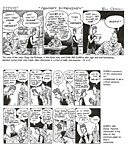 |
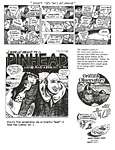 |
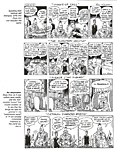 |
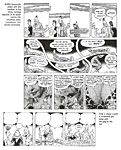 |
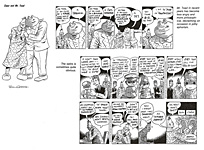 |
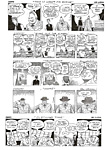 |
 |
 |
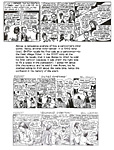 |
